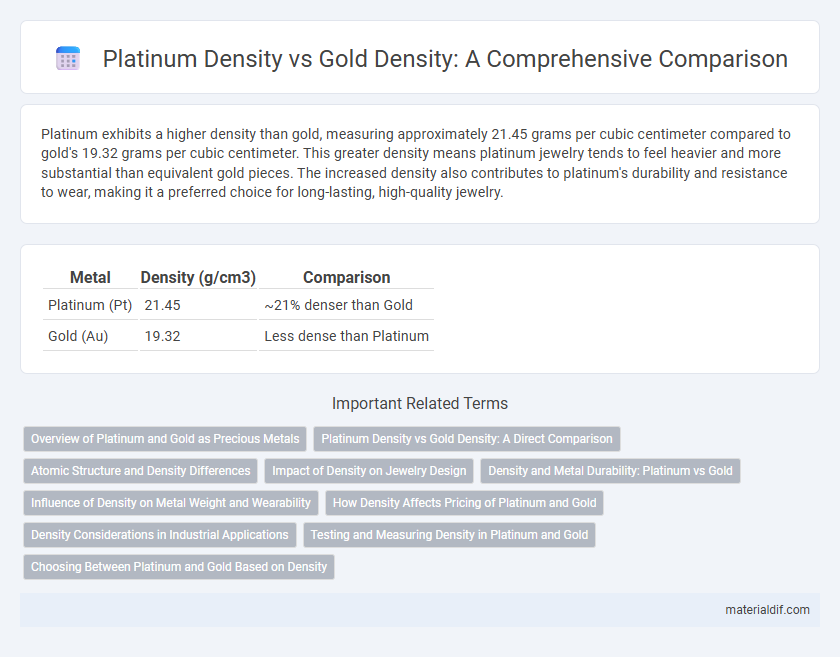Platinum exhibits a higher density than gold, measuring approximately 21.45 grams per cubic centimeter compared to gold's 19.32 grams per cubic centimeter. This greater density means platinum jewelry tends to feel heavier and more substantial than equivalent gold pieces. The increased density also contributes to platinum's durability and resistance to wear, making it a preferred choice for long-lasting, high-quality jewelry.
Table of Comparison
| Metal | Density (g/cm3) | Comparison |
|---|---|---|
| Platinum (Pt) | 21.45 | ~21% denser than Gold |
| Gold (Au) | 19.32 | Less dense than Platinum |
Overview of Platinum and Gold as Precious Metals
Platinum exhibits a density of approximately 21.45 g/cm3, slightly higher than gold's density of 19.32 g/cm3, reflecting its greater mass per unit volume among precious metals. Both metals are highly valued in jewelry, industrial applications, and investment due to their rarity, chemical stability, and resistance to corrosion. The higher density of platinum contributes to its reputation for durability and heaviness in comparison to gold, influencing consumer preference and usage scenarios.
Platinum Density vs Gold Density: A Direct Comparison
Platinum has a density of approximately 21.45 grams per cubic centimeter, making it significantly denser than gold, which has a density of about 19.32 grams per cubic centimeter. This higher density means platinum is heavier and more compact for the same volume compared to gold. The difference in density affects applications in jewelry and industrial uses where weight and durability are critical factors.
Atomic Structure and Density Differences
Platinum has a density of approximately 21.45 grams per cubic centimeter, slightly less than gold's density of about 19.32 grams per cubic centimeter, influenced by their atomic structures. Platinum's atomic number 78 results in a tightly packed face-centered cubic lattice with atomic radii that create a denser arrangement compared to gold's atomic number 79. The difference in atomic mass and electron configuration leads to platinum's higher density despite gold having a heavier atomic weight per atom.
Impact of Density on Jewelry Design
Platinum's density is approximately 21.45 g/cm3, significantly higher than gold's density of around 19.32 g/cm3, which influences the weight and durability of jewelry pieces. The increased density of platinum allows for finer, more intricate designs while maintaining strength and resistance to wear, making it ideal for detailed craftsmanship and lasting heirloom quality. In contrast, gold's lighter density often results in slightly less weighty jewelry, impacting comfort, cost, and the overall feel on the wearer's hand or neck.
Density and Metal Durability: Platinum vs Gold
Platinum has a density of approximately 21.45 grams per cubic centimeter, making it significantly denser than gold, which has a density of about 19.32 grams per cubic centimeter. This higher density contributes to platinum's superior durability and resistance to wear, making it an ideal choice for long-lasting jewelry and industrial applications. The increased metal density also enhances platinum's ability to withstand scratches and maintain its luster compared to gold.
Influence of Density on Metal Weight and Wearability
Platinum, with a density of approximately 21.45 g/cm3, is significantly denser than gold, which has a density of about 19.32 g/cm3, resulting in heavier jewelry pieces of the same size. This increased density influences wearability by making platinum jewelry feel more substantial and durable, often preferred for pieces that endure daily use. The higher density also affects crafting techniques and comfort, as platinum's weight can contribute to a more secure fit but may require adjustments for extended wear.
How Density Affects Pricing of Platinum and Gold
Platinum has a density of approximately 21.45 g/cm3, which is higher than gold's density of about 19.32 g/cm3, making platinum heavier per unit volume. This greater density contributes to platinum's pricing, as more metal mass is contained in the same size item compared to gold, often resulting in higher manufacturing costs. Market prices also reflect this difference, with platinum generally commanding a premium due to its weight and rarity relative to gold.
Density Considerations in Industrial Applications
Platinum has a density of approximately 21.45 grams per cubic centimeter, slightly lower than gold's density of about 19.32 grams per cubic centimeter, influencing material selection in industrial applications. This higher density of platinum provides superior durability and resistance to wear, making it ideal for high-stress environments like catalytic converters and electrical contacts. Density considerations impact cost-efficiency and performance, where platinum's weight contributes to enhanced stability and longevity in heavy-duty uses compared to gold.
Testing and Measuring Density in Platinum and Gold
Testing and measuring the density of platinum and gold involves precise methods such as hydrostatic weighing, where samples are weighed in air and water to calculate their densities accurately. Platinum typically has a density of approximately 21.45 g/cm3, whereas gold has a slightly lower density around 19.32 g/cm3, making density measurements critical for distinguishing between the two metals in jewelry and industrial applications. Advanced techniques like X-ray fluorescence (XRF) complement density testing by confirming elemental composition, ensuring accurate identification and valuation.
Choosing Between Platinum and Gold Based on Density
Platinum has a density of approximately 21.45 g/cm3, making it significantly denser than gold, which has a density of about 19.32 g/cm3. This higher density means platinum jewelry feels heavier and more substantial than gold pieces of the same size, influencing comfort and durability. Choosing between platinum and gold based on density depends on preferences for weight and sturdiness, with platinum offering a heavier, more robust option.
Platinum Density vs Gold Density Infographic

 materialdif.com
materialdif.com